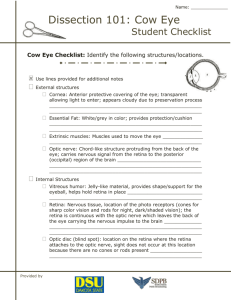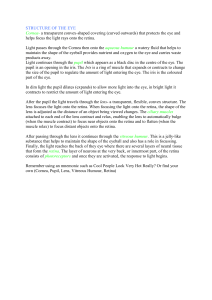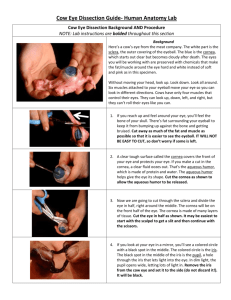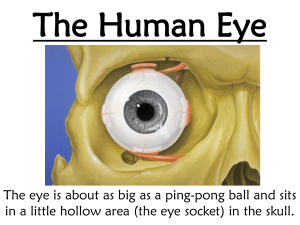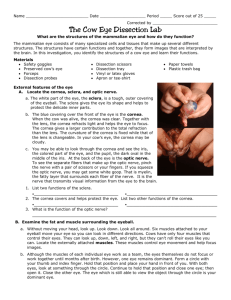Microsoft Word - Cow Eye Dissection
advertisement
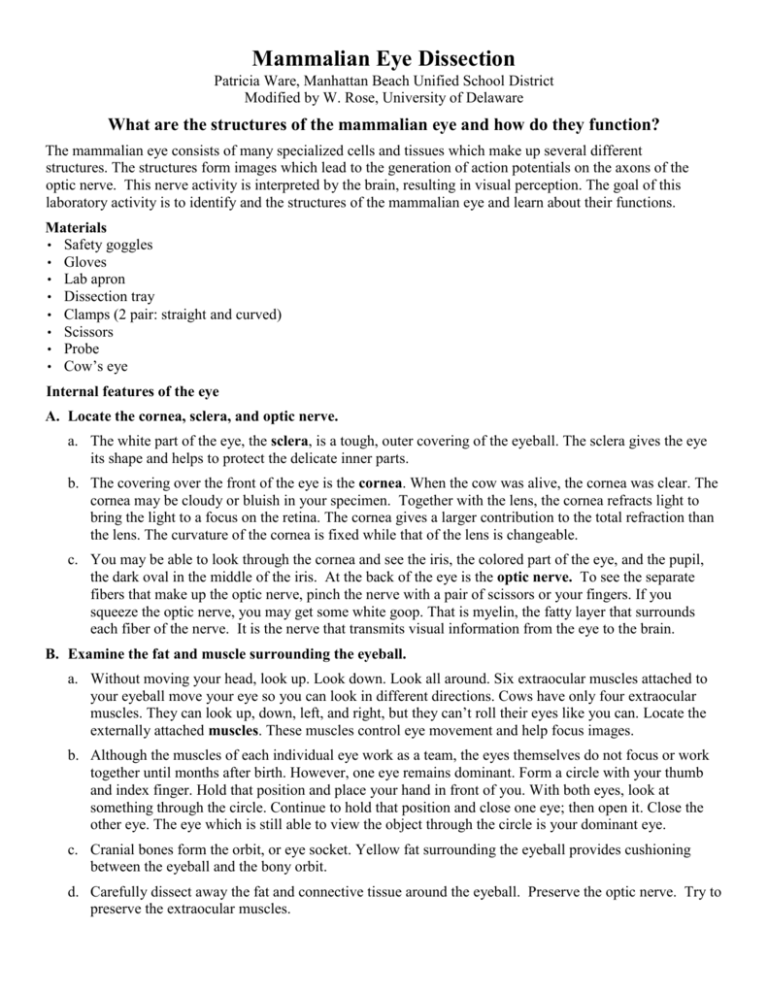
Mammalian Eye Dissection Patricia Ware, Manhattan Beach Unified School District Modified by W. Rose, University of Delaware What are the structures of the mammalian eye and how do they function? The mammalian eye consists of many specialized cells and tissues which make up several different structures. The structures form images which lead to the generation of action potentials on the axons of the optic nerve. This nerve activity is interpreted by the brain, resulting in visual perception. The goal of this laboratory activity is to identify and the structures of the mammalian eye and learn about their functions. Materials • Safety goggles • Gloves • Lab apron • Dissection tray • Clamps (2 pair: straight and curved) • Scissors • Probe • Cow’s eye Internal features of the eye A. Locate the cornea, sclera, and optic nerve. a. The white part of the eye, the sclera, is a tough, outer covering of the eyeball. The sclera gives the eye its shape and helps to protect the delicate inner parts. b. The covering over the front of the eye is the cornea. When the cow was alive, the cornea was clear. The cornea may be cloudy or bluish in your specimen. Together with the lens, the cornea refracts light to bring the light to a focus on the retina. The cornea gives a larger contribution to the total refraction than the lens. The curvature of the cornea is fixed while that of the lens is changeable. c. You may be able to look through the cornea and see the iris, the colored part of the eye, and the pupil, the dark oval in the middle of the iris. At the back of the eye is the optic nerve. To see the separate fibers that make up the optic nerve, pinch the nerve with a pair of scissors or your fingers. If you squeeze the optic nerve, you may get some white goop. That is myelin, the fatty layer that surrounds each fiber of the nerve. It is the nerve that transmits visual information from the eye to the brain. B. Examine the fat and muscle surrounding the eyeball. a. Without moving your head, look up. Look down. Look all around. Six extraocular muscles attached to your eyeball move your eye so you can look in different directions. Cows have only four extraocular muscles. They can look up, down, left, and right, but they can’t roll their eyes like you can. Locate the externally attached muscles. These muscles control eye movement and help focus images. b. Although the muscles of each individual eye work as a team, the eyes themselves do not focus or work together until months after birth. However, one eye remains dominant. Form a circle with your thumb and index finger. Hold that position and place your hand in front of you. With both eyes, look at something through the circle. Continue to hold that position and close one eye; then open it. Close the other eye. The eye which is still able to view the object through the circle is your dominant eye. c. Cranial bones form the orbit, or eye socket. Yellow fat surrounding the eyeball provides cushioning between the eyeball and the bony orbit. d. Carefully dissect away the fat and connective tissue around the eyeball. Preserve the optic nerve. Try to preserve the extraocular muscles. C. Remove the lens and cut the eye in half Use the photos to help you. a. Use a scalpel to make an incision in the cornea. (Careful — don’t cut yourself!) Cut until the clear liquid under the cornea is released. That clear liquid is the aqueous humor. It’s made of mostly of water and keeps the shape of the cornea. b. Use the scalpel to make an incision (cut) through the sclera in the middle of the eye. c. Use your scissors to cut around the middle of the eye, cutting the eye in half. You’ll end up with two halves. On the front half will be the cornea. The cornea is made of pretty tough stuff—it helps protect your eye. It also helps you see by bending the light that comes into your eye. d. Once you have removed the cornea, place it on the board (or cutting surface) and cut it with your scalpel or razor. You may hear a crunch as you cut through the cornea. That’s the sound of the scalpel crunching through layers of protein. The cornea has many layers to make it thick and strong. When the cow is grazing, blades of grass may poke the cow’s eye—but the cornea protects the inner eye. D. Remove the iris. a. The iris is between the cornea and the lens. It may be stuck to the cornea or it may have stayed with the back of the eye. Find the iris and pull it out. It should come out in one piece. b. You can see that there’s a hole in the center of the iris. That’s the pupil, the hole that lets light into the eye. The iris contracts or expands to change the size of the pupil. In dim light, the pupil opens wide to let light in. In bright light, the pupil shuts down to block light out. c. The back of the eye is filled with a clear jelly. That’s the vitreous humor, a mixture of protein and water. It’s clear so light can pass through it. It also helps the eyeball maintain its shape. The vitreous humor is loosely attached to the lens. E. Remove the lens. a. It’s a clear lump about the size and shape of a squashed marble. The lens is a transparent structure in the eye that, along with the cornea, helps to refract and focus light. b. A ring of tiny ciliary muscles, located along the inner side of the iris, connects the lens to the middle layer of the eye. Ciliary muscles contract to change the curvature of the lens. c. Try to identify the ciliary body (ring of smooth muscle) and the suspensory ligaments, also known as zonular fibers, which hold the lens in place. d. The lens of the cow’s eye feels soft on the outside and hard in the middle. Hold the lens up and look through it. In a living organism, it is completely transparent. Your cow lens may not be transparent. To focus on closer objects, it gets “rounder” (more like a sphere, less like a pancake or oblate spheroid). The more spherical lens shape allows it to bend light more strongly, which is necessary to form an image of a close object. e. Put the lens down on this document and look through it at the printed words. If your lens is transparent, it will magnify. F. Examine the retina. a. If the vitreous humor is still in the eyeball, empty it out. b. On the inside of the back half of the eyeball, you can see some blood vessels that are part of a thin fleshy film. That film is the retina. Before you cut the eye open, the vitreous humor pushed against the retina so that it lay flat on the back of the eye. It may be all pushed together in a wad now. c. The retina is made of photoreceptors (rods and cones) and neurons that do the initial stages of visual information processing. The cornea and the lens focus the light that comes into the eye, to make an image on the retina. The photoreceptor cells of the retina experience voltage changes when light hits them. These voltage changes cause changes in neurotransmitter release which cause action potentials in ganglion cells of the retina. Ganglion cell axons travel along the inner surface of the retina to the optic disk, and continue out of the eyeball. In humans, each optic nerve contains 0.8 to 1.7 million axons (Jonas et al., Investigative Opthamology and Visual Science 33(6), 1992). d. Use your finger to push the retina around. The retina is attached to the back of the eye at just one spot. Can you find that spot? That’s the place where axons from all the retina ganglion cells come together. All these nerve axons go out the back of the eye, forming the optic nerve, the bundle of nerves that carries visual information from the eye to the brain. The brain uses this information from the retina to make a mental picture of the world. e. The spot where the retina is attached to the back of the eye is called the blind spot. Because there are no photoreceptors at that spot, you can’t see anything that lands in that place on the retina. G. Check out the tapetum lucidum. Under the retina, the back of the eye is covered with shiny, bluegreen stuff. This is the tapetum lucidum. It reflects light from the back of the eye. Cats, dogs, cows, and many other animals have a tapetum lucidum. When caught in the headlights at night, a cat’s eyes seem to glow, or reflect brightly, because the cat’s tapetum is reflecting light. If you shine a light at a cow at night, the cow’s eyes will shine with a blue-green light because the light reflects from the tapetum. The tapetum improves night vision by reflecting light back to the photoreceptors, but it degrades image quality and therefore reduces visual acuity. Most primates, including humans, do not have a tapetum lucidum. O.C. Bradley, in Outlines of Veterinary Anatomy, Part III (1897), wrote of ruminants (such as cows) that “The Tapetum Lucidum is golden green in colour with a blue periphery.” What color or colors do you observe in your specimen? H. Find your blind spot. To find your blind spot, use the two dots below. Hold one hand over your left eye and look directly at the left-hand dot. At first, you can see both dots even though you're looking directly at only one. As you slowly move the page closer to your eyes, the right-hand dot disappears! If you move your eye, the dot will reappear, but as long as you focus on the first dot, the second will be invisible. Move even closer and the missing dot reappears. You’ve found your blind spot!



